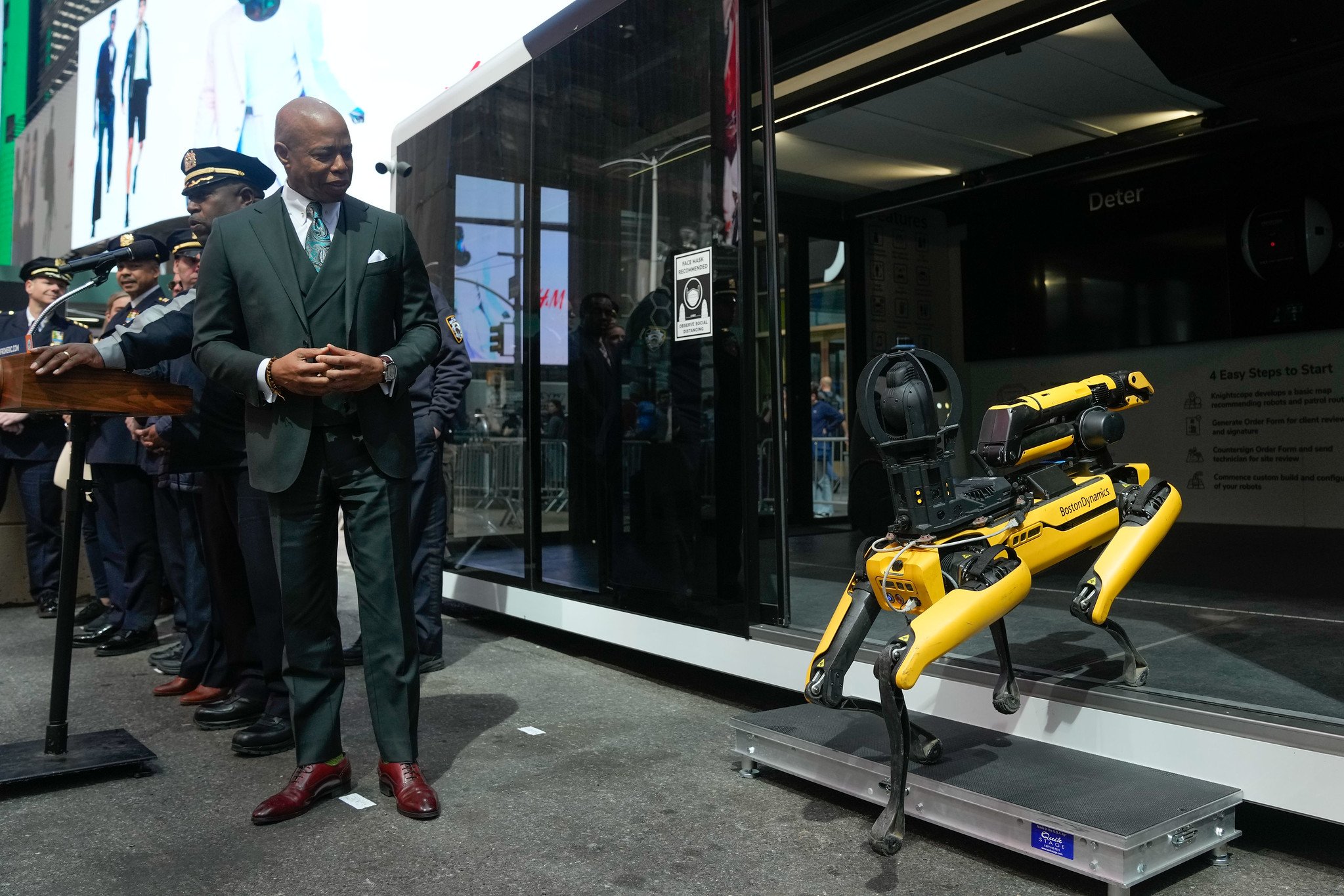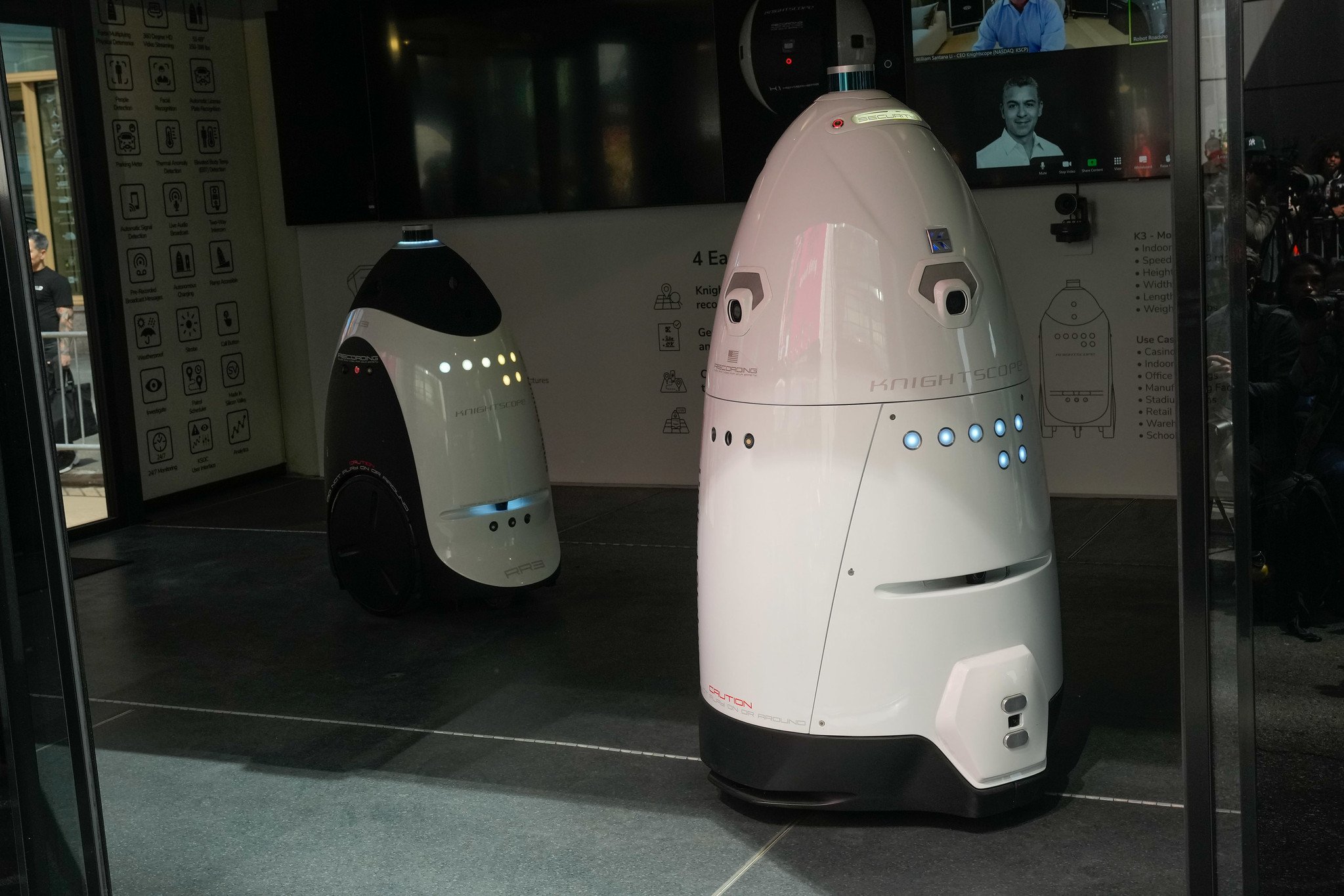Controversial robots to police city streets
/Mayor Eric Adams and “digidog,” which returned to the NYPD on Tuesday after a backlash prompted the program to be axed under former Mayor Bill de Blasio. Photo by Michael Appleton/Mayoral Photography Office
By Ryan Schwach
The future is coming to the New York City Police Department – but not everyone is happy about it.
On Tuesday, top officials with the NYPD and Mayor Eric Adams announced that the city would implement a number of new law enforcement tech tools, including Boston Dynamics’ “digidog,” a robotic dog that drew controversy when it was initially put on city streets under former Mayor Bill de Blasio’s administration.
Along with the “digidog,” the NYPD also announced that they’d soon be using the K5 ASR, a large automated device that will be used to patrol sensitive and confined areas, and the StarChase, a GPS tracking device that can be used to track stolen cars or ghost vehicles. Both the K5 and StarChase will start as pilot programs.
“If we were not willing to move forward and use technology on how to properly keep cities safe, then you will not keep up with those who are doing harmful things to hurt New Yorkers,” Adams said alongside NYPD brass on Tuesday in Times Square. “I'm a computer geek and I believe that technology is here. We cannot be afraid of it.”
Commissher Keechant Sewell introduced the programs, and spoke of the department’s view that they need to keep up with technological advances in crime fighting tools.
“In a forward looking world, it is essential that our officers are equipped with the tools, training and technology necessary to do that job safely and effectively,” she said. “Throughout its history, our department has leveraged the latest available technology and pioneered ways to do our work. Innovations in science and industry have always been reflected in policing, and especially so in the NYPD.”
Sewell, Adams and NYPD Chief of Department Jeffrey Maddrey detailed the three devices and how they will be used.
The K5 bots, which are egg-shaped vehicles that have been compared to both “Star Wars” droid R2-D2 and a Roomba, travel a programmed route and use a camera and artificial intelligence to detect crime. Police said the robots will be used in places like parks or subway stations and that an officer will trail alongside the bot during its pilot phase.
The R2-D2 or Roomba like K5, an artificially intelligent bot that will be part of the NYPD’s new technology-assisted policing. Photo by Michael Appleton/Mayoral Photography Office
“It will provide an alternative additional patrol into confined areas indoor and outdoor such as transit facilities,” said Maddrey. “The K5 uses artificial intelligence to provide real time incident notifications to first responders.”
The StarChase GPS, which can be placed manually or launched as a projectile, can attach to stolen cars as well as “ghost cars” which have paper license plates, and can be tracked across boroughs.
NYPD officials called it a “game changer,” and said the device was already used to track a stolen car from Queens to the Bronx over the weekend.
The last of the rollouts – or more of a return – is the digidog, or “spot”, which was first brought to the city under de Blasio and received so much backlash from New Yorkers and elected officials because of its cost and potential privacy issues, that the city cut the program and put “spot” back in the kennel, something Adams does seem to expect to happen again.
“It was something that was introduced previously under the previous administration and a few loud people were opposed to it and we took a step back,” he said. “That is not how I operate, I operate on looking at what's best for the city.”
“Digidog is out of the pound,” he added, saying he is “willing to go where others are not willing to go to keep the city safe.”
Maddrey added that the use of the robodog will be authorized only through him, and that the city acquired two of them, costing $750,000 of forfeiture money.
Within hours of the announcement, elected officials and advocacy groups voiced the same privacy, over-policing and fiscal concerns the voiced a little over a year ago
“Mayor Adams continues to pour money into the NYPD’s bloated budget, enabling police to impose new, dystopian surveillance technologies throughout the city without meaningfully engaging New Yorkers in a conversation about whether this is how we want to live,” The Legal Aid Society said in a statement.
“This announcement is also another example of the NYPD’s violation of basic norms of transparency and accountability by rolling out these technologies without providing the public a meaningful opportunity to raise concerns,” they added. “The City Council passed the POST Act two years ago to address this very issue, yet the NYPD has once again failed to engage its requirements of public comment before further expanding surveillance technology.”
Legal Aid called on the City Council to hold an oversight hearing into the technologies.
Queens Councilmember Tiffany Cabán, a member of the public safety committee, said that the projects will do little to quell concerns about crime.
“We have schools [without] after school programs. Libraries reducing open hours. Folks going hungry [without] their snap benefits…but we good spending $750,000 on robot dogs to expand our police state and terrorize neighbors,” she said in a tweet. “Show me your budget and I’ll show you your values.”
“It's time we invested in evidence-based approaches to achieving the public safety outcomes we all need and deserve, rather than failed policing and incarceration strategies,” she added.
Cabán’s Queens delegation and public safety committee colleague Bob Holden is in support of the announcement.
“If they could stop a crime, stop a death, stop anything, a risk to an officer or human life and it works. I would say it's worth it,” he told the Eagle. “But it remains to be seen whether these are useful.”
Holden adds that he didn’t know why they were controversial in the first place, and that the cost isn’t necessarily an issue.
“Even if it was a million dollars let's say, would that replace the human that got shot or got bombed?” he said. “I have no problem with technology that can save lives, and if anybody else does, please explain what a human life is worth.”
Regardless of the response, Adams says he intends to introduce digidog, K5 and other future advancements into the city’s communities.
“This is New York, 8.5 million people, 35 million opinions, so no matter what you do, there are going to be pros and cons,” he said. “We are doing what others didn't do. We're putting it right here in Times Square. We're allowing people to come in and look at digidog and K5 and others. And we're gonna bring in community leaders and say here's the technology that we have in your community, allow them to talk about it, hear about it, share their ideas.”





